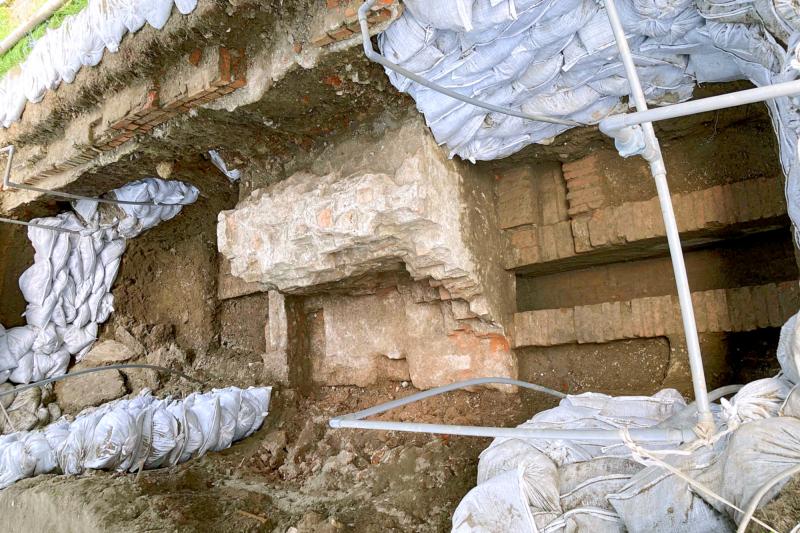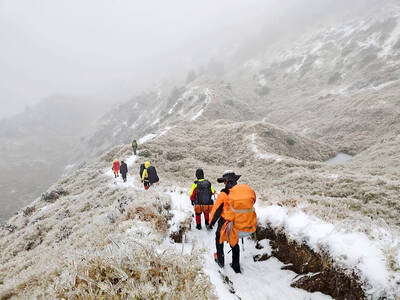Tainan has obtained central government approval to fund an archeology project at Fort Zeelandia that would examine communal life at the fortified Dutch settlement, city officials said yesterday.
Fort Zeelandia and the town of Dayuan (大員) were the foundation for urban life in modern-day Tainan and played a key role in the history of Taiwan, the Tainan Municipal Administration of Cultural Heritage said in a news release.
The archeology research is part of the agency’s project to reconstruct the historical site and NT$5.06 million (US$179,783) has been allocated by the Ministry of Culture’s Bureau of Cultural Heritage toward the effort, it said.

Photo courtesy of the Tainan Municipal Administration of Cultural Heritage via CNA
Shortly after reaching Taiwan in 1642, the Dutch East India Co built the fort in modern-day Anping District (安平) as an important foothold to protect its supply chains, which spanned two oceans, the agency said.
The fort marked the beginning of Taiwan’s entrance into the network of global maritime trade, and Taiwanese Aborigines, Chinese, Japanese and Europeans took part in shaping this historical event, it added.
The ethnic groups living in and around the fort clashed with each other, but also collaborated on shared interests, which set into motion the processes that created modern-day Tainan and Taiwan as a whole, it said.
Past studies of the fort were hindered by limited scope, as efforts were confined to the fort proper and new structures had been built over most of the areas of interest, it said.
National Cheng Kung University, in partnership with the Tainan City Government, has over the past two years explored areas on the periphery of the fort, including Shihmen Elementary School and Sword Lion Square (劍獅埕), it said.
Earlier this year, a research team from the university located outlying walls and a sewage system on the west of the fortification — these had rarely been mentioned in historical documents, it said.
The result of the team’s work showed that on-site research could fill in gaps in the fort’s historiography, it added.
The project would provide a fuller understanding of Fort Zeelandia, which has played a crucial role in Taiwanese history since its founding 400 years ago, the agency said.

Trips for more than 100,000 international and domestic air travelers could be disrupted as China launches a military exercise around Taiwan today, Taiwan’s Civil Aviation Administration (CAA) said yesterday. The exercise could affect nearly 900 flights scheduled to enter the Taipei Flight Information Region (FIR) during the exercise window, it added. A notice issued by the Chinese Civil Aviation Administration showed there would be seven temporary zones around the Taiwan Strait which would be used for live-fire exercises, lasting from 8am to 6pm today. All aircraft are prohibited from entering during exercise, it says. Taipei FIR has 14 international air routes and

The Ministry of National Defense (MND) today released images of the military tracking China’s People's Liberation Army (PLA) movements during the latest round of Chinese drills around Taiwan. The PLA began "Justice Mission 2025" drills today, carrying out live-fire drills, simulated strikes on land and maritime targets, and exercises to blockade the nation's main ports. The exercises are to continue tomorrow, with the PLA announcing sea and air space restrictions for five zones around Taiwan for 10 hours starting from 8:30am. The ministry today released images showing a Chinese J-16 fighter jet tracked by a F-16V Block 20 jet and the

Snow fell on Yushan (Jade Mountain, 玉山) yesterday morning as a continental cold air mass sent temperatures below freezing on Taiwan’s tallest peak, the Central Weather Administration (CWA) said. Snowflakes were seen on Yushan’s north peak from 6:28am to 6:38am, but they did not fully cover the ground and no accumulation was recorded, the CWA said. As of 7:42am, the lowest temperature recorded across Taiwan was minus-5.5°C at Yushan’s Fengkou observatory and minus-4.7°C at the Yushan observatory, CWA data showed. On Hehuanshan (合歡山) in Nantou County, a low of 1.3°C was recorded at 6:39pm, when ice pellets fell at Songsyue Lodge (松雪樓), a

NO SHAME IN RETREAT: Hikers should consider turning back if the weather turns bad or if they do not have sufficient equipment, the Taroko park headquarters said Two people died of hypothermia over the weekend while hiking on Hsuehshan (雪山), prompting park authorities to remind hikers to bring proper equipment and consider their physical condition before setting out in the cold weather. Temperatures dropped over the weekend, bringing snow to high altitudes in Shei-pa National Park. One hiker, surnamed Lin (林), who on Friday was traveling with a group of six along the Hsuehshan west ridge trail, lost consciousness due to hypothermia and died, the Shei-pa National Park Headquarters said. On Saturday, another hiker, surnamed Tien (田), in a group of five on the southeast of the west